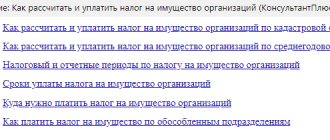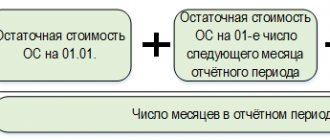Kontur.Accounting - 14 days free!
Friendly, simple and functional online service for small businesses.
Clear for the director, convenient for the accountant! Try it
In recent years, some innovations have appeared in the rules for paying property taxes. The form of the declaration has changed, the procedure for calculating tax based on cadastral value has been adjusted, and new grounds have emerged on which it can be changed. We will cover tax rates, exemptions, reporting and penalties for property taxes in 2020 and 2021.
Object of taxation
The objects of taxation are:
1) for Russian organizations - real estate , recorded on the balance sheet as fixed assets (Article 374 of the Tax Code of the Russian Federation);
2) real estate located on the territory of the Russian Federation and owned by organizations on the right of ownership or right of economic management, as well as received under a concession agreement, if the tax base for such property is determined as their cadastral value entered into the Unified State Register of Real Estate ( Article 375 of the Tax Code of the Russian Federation);
Real estate criteria:
- the presence of a strong connection between the object and the ground (for example, the construction of the object on a monolithic reinforced concrete foundation, the functional or technological connection of this object with other objects by underground communications (cable power lines laid in underground trenches, etc.));
- moving an object is impossible without disproportionate damage to its purpose (including the ability of the object to act in civil circulation as a separate object of civil rights (as opposed to objects that perform an exclusively servicing (auxiliary) function in relation to real estate, including land plots, buildings , structures); the presence of independent useful properties of the object that can be used in economic activity regardless of the land plot on which it is located and other real estate objects located on the common land plot).
These can be buildings, structures, unfinished construction projects, premises, parking spaces, residential buildings, apartments, rooms, cottages and garages. In accordance with the Civil Code of the Russian Federation, real rights to real estate are subject to state registration in the Unified State Register of Real Estate. At the same time, property for which such state registration has not been carried out can also be recognized as real estate. To reasonably classify property as real estate, it is necessary to take into account not only the presence/absence of a record about the object in the Unified State Register of Real Estate, but also the presence of grounds confirming the strong connection of the object with the land and the impossibility of moving it without disproportionate damage to its purpose. For example, for capital construction projects, such grounds may be documents that contain information about the relevant characteristics of the object (technical accounting or technical inventory documents, permits for construction and/or commissioning of the object, design documentation, etc.).
Foreign organizations operating in the Russian Federation through permanent representative offices keep records of taxable items in the manner established in the Russian Federation for accounting.
Movable property recorded on the balance sheet as fixed assets from January 1, 2021 is not subject to property tax.
The list of objects not subject to taxation for corporate property tax is specified in the Tax Code (clause 4 of Article 374 of the Tax Code of the Russian Federation):
- land plots and other environmental management facilities (water bodies and other natural resources);
- property owned by the right of operational management to federal executive bodies and federal state bodies in which the legislation of the Russian Federation provides for military and (or) equivalent service, used by these bodies for the needs of defense, civil defense, security and law enforcement in the Russian Federation ;
- objects recognized as objects of cultural heritage (historical and cultural monuments) of the peoples of the Russian Federation of federal significance in the manner established by the legislation of the Russian Federation;
- nuclear installations used for scientific purposes, storage facilities for nuclear materials and radioactive substances and radioactive waste storage facilities;
- icebreakers, ships with nuclear power plants and nuclear technology service ships;
- space objects;
- ships registered in the Russian International Register of Ships;
- vessels registered in the Russian Open Register of Vessels by persons who have received the status of a participant in a special administrative region in accordance with Federal Law of August 3, 2021 N 291-FZ “On Special Administrative Regions in the Territories of the Kaliningrad Region and Primorsky Territory”;
- aircraft registered in the State Register of Civil Aircraft by persons who have received the status of a participant in a special administrative region in accordance with Federal Law of August 3, 2021 N 291-FZ “On special administrative regions in the territories of the Kaliningrad Region and Primorsky Territory”.
Who will make and submit payments?
According to the legislation of the Russian Federation, payers of property tax are those organizations in respect of which three conditions are met:
- ownership, temporarily, by power of attorney or part-time ownership of real estate and/or movable property included in the balance sheet before 2013, not included in depreciation groups 1 and 2;
- accounting of these property assets is carried out in accounts 01 “Fixed assets” or 03 “income investments in tangible assets”;
- all these assets are provided for by the corresponding article of the Tax Code (Article 374) and are not included in the list of exceptions.
ATTENTION! The specific person in the organization responsible for the calculation and timely payment of property tax is the founder of the trust management (Article 378 of the Tax Code of the Russian Federation).
Criteria for fixed assets
Fixed assets from an accounting point of view are assets that meet the following conditions:
- the object is intended for use in the production of products , performance of work, provision of services;
- the object is intended for use for a period exceeding 12 months ;
- subsequent resale of the object is not expected;
- the object is capable of generating economic benefits .
The criteria for fixed assets for tax purposes are somewhat different from those for accounting and are established by Chapter 25 of the Tax Code, namely, paragraph 1 of Article 256. In the Tax Code, fixed assets are classified as depreciable property. The following property is considered depreciable:
- Is owned or operated by the organization. Exception: fixed assets, the right to which is subject to mandatory state registration, are included in depreciable property from the moment the documents are submitted, clause 11 of Article 258 of the Tax Code;
- Used for the purpose of generating income;
- Intended for use over 12 months;
- Costing more than 40,000 rubles. From the beginning of 2021 For tax purposes, property with an original cost of 100 thousand rubles or more will be considered depreciable.
Please note: That property that meets all the criteria, but is less than the cost limit, is written off as material expenses.
Federal and regional nuances of tax rate formation
The rules for calculating and paying corporate property taxes, common to all subjects of the Federation, can be found in the thirtieth chapter of the Tax Code of the Russian Federation.
However, within the framework of these rules, regional authorities have the right to introduce additional benefits that do not contradict the provisions enshrined in the Code. For example, a region can set local property tax rates for legal entities. However, such a rate cannot exceed 2.2%. The region can also set its own deadlines for paying fees and advances, as well as reporting periods (limited by the tax period).
In addition, regional authorities also have the right to draw up and approve at the legislative level separate lists of objects exempt from paying this fee.
The tax base
In general, the tax base for the property tax of legal entities is determined as the average annual value of property recognized as an object of taxation, and such property must be accounted for at its residual value.
Taking into account the changes of 2014, in relation to individual real estate objects, the tax base is now determined as their cadastral value. Since 01.01.2020, the Tax Code of the Russian Federation classifies not only fixed assets, but also any real estate owned by organizations under the right of ownership or right of economic management, as objects of taxation at cadastral value. Thus, it will not matter whether real estate is taken into account as a fixed asset or not - you will still have to charge and pay tax according to the cadastre. True, unless the region decides otherwise. Previously, if objects were not registered as fixed assets, tax, according to cadastral valuation, was not paid on them.
List of real estate taxed by legal entities at cadastral value (Article 378.2 of the Tax Code of the Russian Federation):
- administrative and business centers and shopping centers (complexes) and premises in them;
- non-residential premises, the purpose, permitted use or name of which, in accordance with the information contained in the Unified State Register of Real Estate, or documents of technical registration (inventory) of real estate, provides for the placement of offices, retail facilities, public catering and consumer services, or which are actually used for placement offices, retail facilities, public catering and consumer services;
- objects of real estate of foreign organizations that do not carry out activities in the Russian Federation through permanent missions, as well as objects of real estate of foreign organizations not related to the activities of these organizations in the Russian Federation through permanent missions;
- residential premises, garages, parking spaces, unfinished construction projects, as well as residential buildings, garden houses, outbuildings or structures located on land plots provided for personal farming, vegetable gardening, horticulture or individual housing construction.
To pay tax at cadastral value, two conditions must be met:
- the cadastral value of the objects has been established;
- Regional laws indicate that objects are taxed at cadastral value.
If at least one of these requirements is not met, the tax on such objects must be calculated at the average annual cost, provided that they are taken into account in accounting as fixed assets. Exception: organizations on the simplified tax system and UTII. They do not pay tax on the average annual cost of new properties (clause 2 of article 346.11, clause 4 of article 346.26 of the Tax Code)
Data on cadastral value can be found:
- on the Rosreestr website;
- Public cadastral map;
- Government services.
At average annual cost
Real estate that:
- not taxed at cadastral value in accordance with regional legislation;
- belongs to the organization by right of ownership, economic management or operational management;
- accepted for accounting as part of fixed assets and reflected in accounts 01 or 03.
Real estate that was received under a concession agreement and reflected in off-balance sheet accounts is also taxed at the average annual cost.
Advance tax payments are made quarterly. Calculation for the quarter is carried out according to the following formula:
Property tax at average annual value = Average value of fixed assets for the reporting period × Tax rate / 4
For example, to calculate the down payment for the first quarter, you need to add up the residual value of the property on January 1, February 1, March 1 and April 1. The result obtained is divided by 4. For the calculation at the end of the year, the procedure is similar.
Separate divisions pay tax at the rate of the region where the division is registered. If the property is not located at the place of registration of the parent organization or division, then the tax is calculated at the rate of the region where the property is located.
Example of calculating property tax based on average annual value
The tax base is calculated by adding the residual value of each object on the first day of each month and on the last day of the billing period. The tax base of depreciated objects is zero, but the objects are included in the report.
Residual value of fixed asset:
- January 1 - 150,000 rubles
- February 1 - 145,000 rubles
- March 1 — 140,000 rubles
- April 1 — 135,000 rubles
- May 1 - 130,000 rubles
- June 1 - 125,000 rubles
- July 1 - 120,000 rubles
- August 1 - 115,000 rubles
- September 1 - 110,000 rubles
- October 1 - 105,000 rubles
- November 1 - 100,000 rubles
- December 1 — 95,000 rubles
- December 31 — 90,000 rubles
Advance payment for 1st quarter
Tax base = (150,000 + 145,000 + 140,000 + 135,000) / 4 = 142,500 rubles Payment = 142,500 × 2.2% / 4 = 783.75 rubles
Advance payment for half a year
Tax base = (150,000 + … +125,000 + 120,000) / 7 = 135,000 rubles Payment = 135,000 × 2.2% / 4 = 742.5 rubles
Advance payment for 9 months
Tax base = (150,000 + … + 105,000) / 10 = 127,500 rubles Payment = 127,500 × 2.2% / 4 = 701.25 rubles
Additional tax payment for the year
Tax base = (150,000 + … + 90,000) / 13 = 120,000 rubles Payment = 120,000 × 2.2% – (783.75 + 742.5 + 701.25) = 412.5 rubles
Procedure for calculation and payment
The amount of property tax for organizations is calculated based on the results of the tax period to which the calendar year relates.
From 01/01/2020 Tax calculations for advance payments based on the results of reporting periods (I quarter, I half of the year, 9 months) do not need to be submitted (clause 2 of Article 386 of the Tax Code of the Russian Federation will no longer be in force). However, the obligation to make advance payments has not been cancelled. They must be transferred to the budget according to the old rules.
Also, based on the results of each reporting period (first quarter, half of the year and nine), it is necessary to calculate the amount of advance payments in the amount of 1/4 of the product of the tax base and the tax rate. Thus, the final amount of tax payable to the budget is determined as the difference between the amount of tax for the tax period and the amounts of advance payments .
What is the difference between paying property tax by Russian and foreign organizations? Property tax and advance payments are subject to payment by the taxpayer in the manner and within the time limits established by the constituent entities of the Russian Federation.
However, in relation to property located on the balance sheet of a Russian organization, tax and advance payments are subject to payment to the budget at the location of the specified organization. Foreign organizations operating in the Russian Federation through permanent representative offices pay taxes and advance payments to the budget at the place where these permanent representative offices are registered with the tax authorities.
According to cadastral value
Many companies calculate tax based on cadastral value. The authorities must warn organizations and publish a list of property for payment of tax at cadastral value before January 1 on the region’s official website. A closed list of real estate objects taxed at cadastral value is given in Article 378.2 of the Tax Code of the Russian Federation.
There are four mandatory conditions for taxing real estate at cadastral value:
- the property is located on the territory of the Russian Federation;
- real estate belongs to the organization under the right of ownership, economic management or received under a concession agreement;
- the cadastral value of real estate is determined by the region;
- in the region, the procedure for taxation of real estate has been approved and the specific types of property from Article 378.2 of the Tax Code of the Russian Federation to which it applies are specified.
If an object is not specified in the law, then it is taxed at the average annual cost. If the type of objects is specified in the law, but the cadastral value is not determined according to it, then the tax is also paid on the average annual value.
The procedure for real estate accounting for cadastral tax does not matter. It can be listed both as part of the fixed assets and as part of current assets or off the balance sheet.
The tax base in this case is the cadastral value of the property indicated in the Unified State Register of Real Estate as of January 1 of the year for which the payment is calculated. For each object, the base is determined separately.
The reporting periods for property tax calculated based on cadastral value are 1st quarter, 2nd quarter and 3rd quarter. Calculate the tax using the formula:
Property tax by cadastral value = Cadastral value of property as of January 1 × Tax rate
If your region provides advance payments, then the quarterly payment is equal to a quarter of the tax amount. When calculating the final payment for the year, simply subtract the listed advance payments from the amount received.
An example of calculating property tax based on cadastral value
Vozdushny Shar LLC owns a shopping center, which is subject to property tax at cadastral value. As of January 1, 2021, its cadastral value was 120,000,000 rubles. The property tax rate in the region is 2%.
Advance payment for the first quarter = 120,000,000 × 2% / 4 = 600,000 rubles;
Advance payment for the second quarter = 120,000,000 × 2% / 4 = 600,000 rubles;
Advance payment for the third quarter = 120,000,000 × 2% / 4 = 600,000 rubles;
Tax payable at the end of the year = 120,000,000 × 2% – 1,800,0000 = 600,000 rubles.
Features of tax calculation and advance payments
In some cases, the formula for calculating tax changes. Features may arise when receiving benefits, having data on the cadastral value only for the entire building, buying or selling real estate in the middle of the year, or changing the cadastral value. Let's look at them all:
1. Real estate is subject to benefits. The benefit can be provided in the form of a non-taxable part of the cadastral value or a tax reduction. In the first case, you need to subtract the non-taxable part of the cadastral value from the cadastral value approved as of January 1 in the Unified State Register of Real Estate and calculate the tax on the remainder. In the second case, subtract the amount of the benefit from the tax calculated using the standard formula.
2. The cadastral value is determined only for the building, and you own the premises. Calculate your tax for the year and advance payments as usual. To determine the tax base, find the cadastral value of your premises in proportion to its area in the entire building.
3. The property was bought or sold in the middle of the year. Use the ownership coefficient (clause 5 of Article 382 of the Tax Code of the Russian Federation). It shows the ratio of the number of months you owned the property to the total number of months in a year or quarter.
4. The cadastral value was revised in the middle of the year . If the characteristics of the object have changed and its value has been revised, adjust the tax and advance payments (clause 5.1 of Article 382 of the Tax Code of the Russian Federation). The adjustment coefficient shows the ratio of the number of months in which the old cost was in effect to the total number of months.
5. In the middle of the year, the authorities excluded the property from the list of property for payment of tax at cadastral value . Recalculate the tax from the beginning of the year at the average annual cost.
Deadlines for submitting reports
From January 1, 2021, taxpayers will report property taxes only based on the results of the tax period. There is no longer a need to submit quarterly calculations of advance payments to the Federal Tax Service. The form of the declaration, as well as the procedure and format for its submission, were approved by Order of the Federal Tax Service of the Russian Federation dated August 14, 2019 No. SA-7-21/ [email protected]
If a taxpayer is registered with several tax authorities of one constituent entity of the Russian Federation at the location of real estate, the tax base for which is determined as the average annual cost, then the taxpayer is assigned the right to submit a single property tax return. Now the taxpayer can choose the tax authority to which he will submit the declaration, but is obliged annually before March 1 of the year, which is the tax period, to notify the tax authority of the constituent entity of the Russian Federation about this. The notification form was approved by order of the Federal Tax Service of Russia dated June 19, 2019 No. ММВ-7-21/ [email protected]
The deadline for submitting the declaration is no later than March 30 of the year following the tax period.
Correct calculations
The Federal Tax Service of the Russian Federation has developed a special form for submitting calculations of quarterly payments for property tax (approved by Order of the Federal Tax Service dated November 24, 2011 No. ММВ-7-11/895). According to this order, this can also be done electronically, and for organizations with a large number of personnel this requirement is mandatory.
NOTE! If the organization has more than 100 personnel for the reporting year, it is impossible to submit calculations in paper form, such documents will not be considered submitted, and the organization will be fined (clause 3 of Article 80 of the Tax Code of the Russian Federation).
Filling out the form requires entering the following data.
The title page should include:
- company details;
- correction code (is it a primary or updated document);
- reporting period code and year;
- Tax office code (look on the Federal Tax Service website);
- full name of the company;
- OKVED code;
- contact number;
- number of pages in calculation;
- number of application sheets (if any);
- the date of recieving;
- signature of the responsible person.
Section 1 – justification of the amount contributed to the budget as an advance payment for property tax. Section 2 – calculation of property tax on objects reflected at book value (separately for each category of assets). Section 3 – calculation of property tax on objects reflected at cadastral value.
Calculation of property tax for legal entities
Currently, taxes are calculated in most cases using accounting software. I'll tell you how we will do this in 2021 using a short example.
LLC "A" is registered in the Smolensk region, applies the general taxation system, has equipment worth 1,200,000 rubles and a car worth 600,000 rubles on its balance sheet. The property was purchased for a fee. In the Smolensk region, the tax rate on real estate is 2.2%, on movable property - 1.1%. Let's consider the procedure based on the above conditions.
- We set property tax rates. To do this, open “Settings” - “Taxes and reports” - “Property tax”. We set the tax rates approved for the Smolensk region for movable and immovable property;
- In the directory “Nomenclature” and “Fixed Assets” we fill in the data on our property: name, financially responsible person (MRP), method of recording expenses, benefits, inventory card;
- We accept equipment for registration. In the section “OS and intangible assets” we fill out the document “Receipt of equipment”. Then, in the “OS and intangible assets” section, fill out the “Acceptance for accounting” document. We reflect the initial cost of the equipment, useful life, and method of calculating depreciation;
- We accept the car for accounting. In the section “Fixed assets and intangible assets” we fill out the document “Receipt of fixed assets”, we fill in the initial cost, car accounting and depreciation accounts, useful life (service life);
- We perform month closing every month. The program automatically calculates depreciation and writes it off to the organization's expenses;
- When closing the quarter, the program automatically calculates the tax. In the balance sheet, property tax will be reflected in account 68.08.
If you do not use an accounting program or need to calculate some special case, we recommend an online calculator to calculate the property tax of organizations.
How to check
Tax authorities may punish you for significant errors in calculations. To eliminate inaccuracies in calculating fiscal tranches, use a free online property tax calculator.
To check, you will need to indicate the current rate of tax liability and enter information about the residual value of real estate assets that are recognized as taxable objects.
IMPORTANT!
Enter data into the online calculator based on accounting reporting data. To do this, prepare in advance a turnover sheet or cards for accounts 01 and 03 for the corresponding accounting dates in the context of accounting objects.
Payment of property tax by organizations under special regimes
We are talking about the entry into force of Federal Law No. 52-FZ of 04/02/2014, according to which the obligation of these taxpayers to pay property tax in respect of real estate is established, the tax base for which is determined as its cadastral value. Who does this innovation apply to? The new rule applies both to organizations using the simplified tax system and to organizations using UTII.
What is the difference between innovations for simplifiers and companies on UTII? For companies using UTII, the obligation to pay property tax arose on July 1, 2014, while organizations using the simplified tax system began on January 1, 2015.
Local authorities are obliged to approve, in accordance with the established procedure, the results of determining the cadastral value of objects. Moreover, they must conduct a cadastral valuation of real estate at least once every five years. A list of real estate objects in respect of which the new taxation procedure applies must also be determined. Thus, it is important to remember that now, in relation to individual fixed assets, the tax base for corporate property tax is calculated based on the cadastral value. And the tax on such property of organizations will now have to be paid by both simplified organizations and organizations under imputation.
Firmmaker, August 2014 (updated in January 2021) Alina Marina When using the material, a link is required
Who doesn't have to worry about property taxes?
Some business entities are legally exempt from the obligation to pay property tax. These include the following groups of businessmen.
- Organizations whose balance sheet accounts do not have fixed assets that can be recognized as objects of property tax.
- The organization's property is associated with oil production in offshore fields.
- Property of individual entrepreneurs and individuals.






